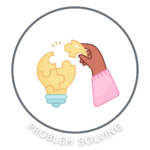
Problem-solving is a foundational skill for young children. For preschoolers, especially those in special education, learning to solve problems independently builds confidence and resilience. Special educators have the unique opportunity to introduce these skills early, helping children manage challenges in healthy ways. One effective way to teach problem-solving is through an Interactive Problem-Solving Toolbox for Preschoolers.
This hands-on activity allows students to create a personalized toolbox filled with strategies they can choose to solve problems. With this approach, children feel empowered as they select strategies that resonate with them. Let’s explore how to guide preschoolers through building their own problem-solving toolbox, making it a fun and educational experience.
What is the Interactive Problem-Solving Toolbox for Preschoolers?
The Interactive Problem-Solving Toolbox for Preschoolers is an engaging activity designed to help young learners identify and use different strategies for overcoming challenges. Through this activity, children choose problem-solving tools that work best for them, building a personalized set of strategies.
This toolbox is a visual and tactile resource that empowers students to make choices, practice decision-making, and feel prepared when they encounter everyday issues. Whether it’s managing emotions, sharing with friends, or asking for help, this toolbox gives preschoolers the confidence to navigate challenges independently.

Benefits of Teaching Problem-Solving Skills
The problem-solving toolbox offers many benefits for young learners. Here’s why it’s a valuable tool for preschool special educators.
1. Promotes Independence
Preschoolers learn to solve problems on their own by choosing strategies that work for them. This independence builds self-confidence, encouraging students to rely on themselves when challenges arise.
2. Supports Emotional Regulation
Many problem-solving strategies focus on managing emotions, like deep breathing or counting to ten. Learning these strategies early helps children handle frustration, sadness, and other emotions in healthy ways.
3. Develops Decision-Making Skills
Selecting tools for their toolbox teaches students about choices and consequences. Decision-making is a key life skill that prepares preschoolers for future challenges in school and beyond.
4. Makes Learning Fun
The hands-on aspect of building a toolbox engages preschoolers and keeps learning enjoyable. The more fun the activity, the more motivated children are to participate and remember the strategies.
How to: Problem-Solving Toolbox for Preschoolers
Creating an Interactive Problem-Solving Toolbox for Preschoolers in your classroom is simple and effective. Follow these steps to guide young learners through building their personalized toolbox.
Step 1: Introduce the Concept of Problem-Solving
Start by explaining what it means to solve a problem. Use simple language, such as, “Solving a problem means finding a way to make things better.” Give examples of everyday challenges they may face, like waiting their turn or feeling frustrated when something doesn’t go as planned.
Step 2: Present Problem-Solving Strategies
Introduce a set of problem-solving strategies that preschoolers can choose from. Strategies might include:
- Deep Breathing: Take slow breaths to feel calm.
- Counting to Ten: Pause and count to calm down.
- Ask for Help: Find a teacher or friend for assistance.
- Take a Break: Step away from the situation for a moment.
- Use Words: Practice saying, “I feel…” or “Can I have a turn?”
Keep the options simple and use visual aids, like pictures or icons, to help preschoolers understand each strategy.
Unlock all of our preschool materials by signing up for your free trial today – no credit card required!
Access the full Social Communication Curriculum HERE!
Instant access to thousands of no-prep social skills activities, over 1000+ video lessons, and engaging games designed to enhance learning and development.
FAQs for Special Educators
Q: How often should I use the Interactive Problem-Solving Toolbox for Preschoolers?
A: Integrate the toolbox into daily routines. Consistent practice reinforces problem-solving skills and builds students’ confidence.
Q: What if a student’s preferred strategy doesn’t work for them?
A: Encourage them to try another tool. Problem-solving is about flexibility, and it’s okay if one strategy doesn’t work every time.
Q: How can I measure students’ progress in problem-solving?
A: Observe how students handle challenges over time. Look for signs of independence and emotional regulation as indicators of progress.
Everyday Speech’s Resources for Teaching Problem-Solving Skills
Everyday Speech offers a range of resources to support preschool educators in teaching problem-solving skills. The Interactive Problem-Solving Toolbox for Preschoolers is just one example. Everyday Speech’s curriculum includes video modeling, interactive worksheets, and social-emotional learning activities that make teaching problem-solving skills easier and more effective.
By using Everyday Speech’s resources, you can guide students in building their own toolbox of strategies, helping them become confident, capable problem-solvers. With these tools, special educators can create a nurturing learning environment that empowers young learners.
Conclusion
Teaching problem-solving skills to preschoolers lays the foundation for a lifetime of resilience and independence. The Interactive Problem-Solving Toolbox for Preschoolers is a powerful tool that gives young learners the strategies they need to manage challenges. By building a personalized toolbox, children feel more confident and prepared to face problems in healthy, constructive ways.
Incorporate the Interactive Problem-Solving Toolbox for Preschoolers into your classroom to support students’ social and emotional growth. With consistent practice and encouragement, you’ll see preschoolers become thoughtful, independent problem-solvers, ready to take on life’s challenges with confidence.
Sample Video
Students learn best by watching others their same-age model the behavior! Check out a sample video modeling lesson below. We offer our entire Social-Emotional Learning platform free for 14 days here!
Related Blog Posts:
Preschool and Kindergarten Social Communication and SEL Materials are Now Live!






